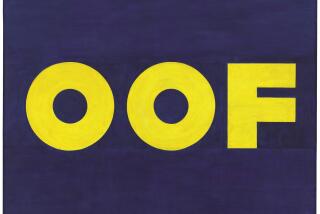ART REVIEW : Cruikshank’s Work Finds Humor in Life’s Inequities
- Share via
If Isaac Cruikshank were alive today he could be in a lot of trouble. He lived mainly in the 18th Century and always in Britain, where he was a popular satirical draftsman. By present standards he was politically incorrect.
A very fine spread of his work on view at USC’s Fisher Gallery shows his pen needled just about everybody in sight. Pretty young women were gold diggers, old men were sexist satyrs. Everybody got it, the fat, the foreign, the disabled, the righteous and the damned.
Titled “Isaac Cruikshank and the Politics of Parody” this is the most comprehensive exhibition of Cruikshank’s yet done, presenting more than 100 little watercolors on loan from the fabled holdings of the Huntington Library and Art Gallery in San Marino. Organized by its art gallery director Edward J. Nygren in collaboration with the university’s museum studies class of 1995, the exhibit is handsomely hung, professionally presented and fleshed out with a fully illustrated catalogue.
The century was a great one for satire. Apparently the Enlightenment’s quest for objective understanding coupled with the rococo’s urge to fun resulted in the realization that humanity, rationally examined, in fact, does not make sense. The insight created a paradoxical backlash to a medieval notion that the secular world is a dung-heap of vanity and folly. Since reality was vicious and God was going out of fashion, the only sensible way to deal with life was to laugh.
In England the urge to parody first bit James Hogarth and went on to infect Cruikshank and such colleagues as James Gilray and Thomas Rowlandson, not to mention Cruikshank’s own son George, who outstripped him in fame. In Spain Goya turned the idea of satire into a searing denunciation of the Inquisition.
*
Cruikshank’s gifts were more modest. Whimsy, drollery and burlesque were his forte. As Nygren’s catalogue essay points out, the theater, with its broadly drawn comic types, was his main inspiration. Like his fellow comedians, he made his drawings as studies for prints intended for popular consumption. Unlike them he was not into the bile of full-blown caricature.
His drawing line is crisp and fresh with a slightly eccentric edge of diffident awkwardness. His watercolor tints capture Gainsborough’s lightness of touch. He keeps his figures in the middle ground like actors on stage. This objective distance creates a gentle, shrugging detachment that feels more bemused than bitter.
The exhibition is divided into thematic categories such as “Wheel of Fortune,” “Love and Marriage” and “Fools for Fashion,” echoing the Enlightenment’s passion for types and categories. At a glance it looks like this pigeonholing practice shrinks the individual down to a one-dimensional stereotype. That makes for bad art as well as unfair discrimination. But look again.
“The Rabbits” shows a vendor of color kneeling before a white woman, offering his wares. The subservient pose offends us today, but the real story is more complex and decidedly funnier. The woman is actually a domestic servant putting on airs. When she complains the proffered rabbit does not smell fresh, the vendor’s slightly obscene rejoinder proves he feels free to take no guff from anyone. Cruikshank actually shows characters departing from stereotype, making them fully rounded humans.
“None But the Brave Deserves the Fair” depicts two old duffers fighting over a beautiful courtesan. Despite its trappings as a genre piece it alludes to Milton’s “Paradise Lost” recasting the three comic characters as Satan, Sin and Death. Stereotypes become archetypes reflecting the universal condition.
“The Doctor Snatching at the Guinea After His Patient Is Dead” could be enlisted in today’s wrangle over health-care reform. Maybe not. The gouging physician may not be the only villain in the piece. He is tussling with two domestics who could be trying to steal the money from him. Cruikshank undermines class prejudice in both directions. He introduces a sense of modern ambiguity.
The real butt of Cruikshank’s larger joke is less the individual than the inequities of life. The villain of the piece is the hypocrite who exploits inequity under the guise of idealism.
In the end, humor is always on the side of tolerance. It functions cathartically to remind us that, in the end, we are all slightly absurd.
* USC, Fisher Gallery, 823 Exposition Blvd., to April 16, closed Sundays and Mondays, (213) 740-4561.
More to Read
The biggest entertainment stories
Get our big stories about Hollywood, film, television, music, arts, culture and more right in your inbox as soon as they publish.
You may occasionally receive promotional content from the Los Angeles Times.









